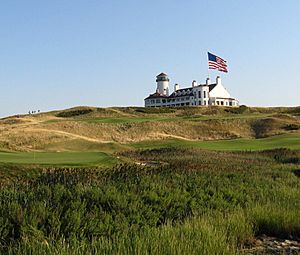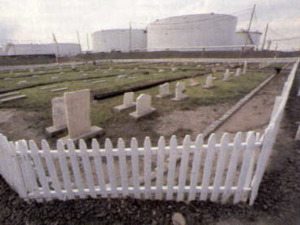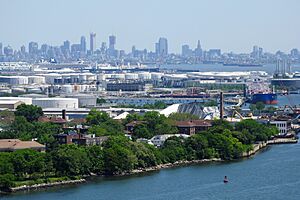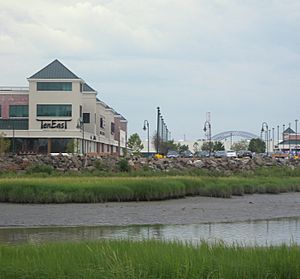Constable Hook facts for kids
Constable Hook is a piece of land, like a small peninsula, in Bayonne, New Jersey. It's located where the Kill van Kull waterway flows into the Upper New York Bay. This area has always been very important for shipping and moving goods in the Port of New York and New Jersey. A lighthouse called Robbins Reef Light helps guide ships safely nearby. In recent years, some old industrial areas here have been cleaned up and turned into places for fun, like golf courses and shops.
Historically, the name Constable Hook referred to a larger area. On March 15, 1861, Constable Hook became part of the new Township of Bayonne. Soon after, Bayonne officially became a city.
Contents
History of Constable Hook
Early Days and the Van Buskirk Family
The name "Constable Hook" comes from the Dutch language. In 1646, the Dutch West India Company gave this land to Jacob Jacobsen Roy. He was a "constable" or chief gunner at Fort Amsterdam in New Amsterdam, which was the capital of New Netherland. The Dutch called the area "Konstapel's Hoeck," meaning "Constable's Hook," after his title. However, Roy never actually lived on the land.
The first person to settle here was likely Pieter Van Buskirk. Around 1700, he built a stone house on Constable Hook. This spot became known as Van Buskirk's Point. In 1736, he started a small family cemetery next to his house. Both he and his wife were buried there.
Later, in 1798, some of Van Buskirk's family sold part of Constable Hook. A company called Hazard Powder Co. built a factory and a dock there. This factory made gunpowder for the U.S. Navy during the War of 1812.
The Van Buskirk family cemetery is still there today. It's sometimes called "Hook Cemetery" or "Bayonne Cemetery." In the 1980s, parts of the cemetery were restored.
Port Johnston and the Railroad
The southwestern part of Constable Hook became an industrial area called Port Johnston. In 1864, the Central Railroad of New Jersey built train tracks through Bayonne to Constable Hook. After the American Civil War, they built the Port Johnston Coal Docks. At that time, it was the biggest coal port in the world!
Many Irish immigrants came to work for the railroad and lived in Constable Hook. So many Irish families moved there that people in Bayonne called the area "Irishtown." In 1877, workers at the Port Johnston Coal Docks went on strike. They stopped working to ask for better conditions.
Oil Refineries and Storage
In 1872, John D. Rockefeller's Standard Oil company bought a large amount of land on Constable Hook. By 1885, a pipeline connected this area to oil fields in Texas. Other oil companies also built refineries here. These companies attracted many immigrants from Eastern Europe.
The original Van Buskirk farmhouse was taken down in 1906 by Standard Oil. They needed more space for their growing refinery. Standard Oil later helped to fix up the old cemetery.
On July 4, 1900, a big fire started at the Standard Oil refinery. Lightning caused some large oil tanks to explode. The burning oil spread into New York Bay. It took three days to put out the fire.
Later, in 1915 and 1916, workers at the Standard Oil Company went on strike. They wanted better wages and to form a union. There were some difficult times during these strikes. Eventually, the strikes ended, and Standard Oil agreed to give everyone a raise.
Today, a company called IMTT has large facilities on Constable Hook for storing liquids. This company sold its facilities to another company in 2014.
Over the years, oil facilities caused some environmental damage. Exxon, another oil company, is now responsible for cleaning up the area. They have been working to investigate and clean the soil and groundwater. This cleanup work includes removing contaminated soil and installing systems to protect the environment.
New Uses for Old Land
Much of eastern Constable Hook used to be the city dump. Now, this area is home to the Bayonne Golf Club. The golf club even has a lighthouse-like building on a hill, which serves as its clubhouse.
At the northern end of Constable Hook, you'll find South Cove Commons. This is a shopping mall built in the late 1900s. East of the mall, there's a public nature walk along the shore. From here, you can see tidal mudflats and the beautiful New York Harbor. The Hudson River Waterfront Walkway also runs along the northern shore of the cape, offering nice views. In 2012, the Bayonne Energy Center opened here, which helps provide power.





